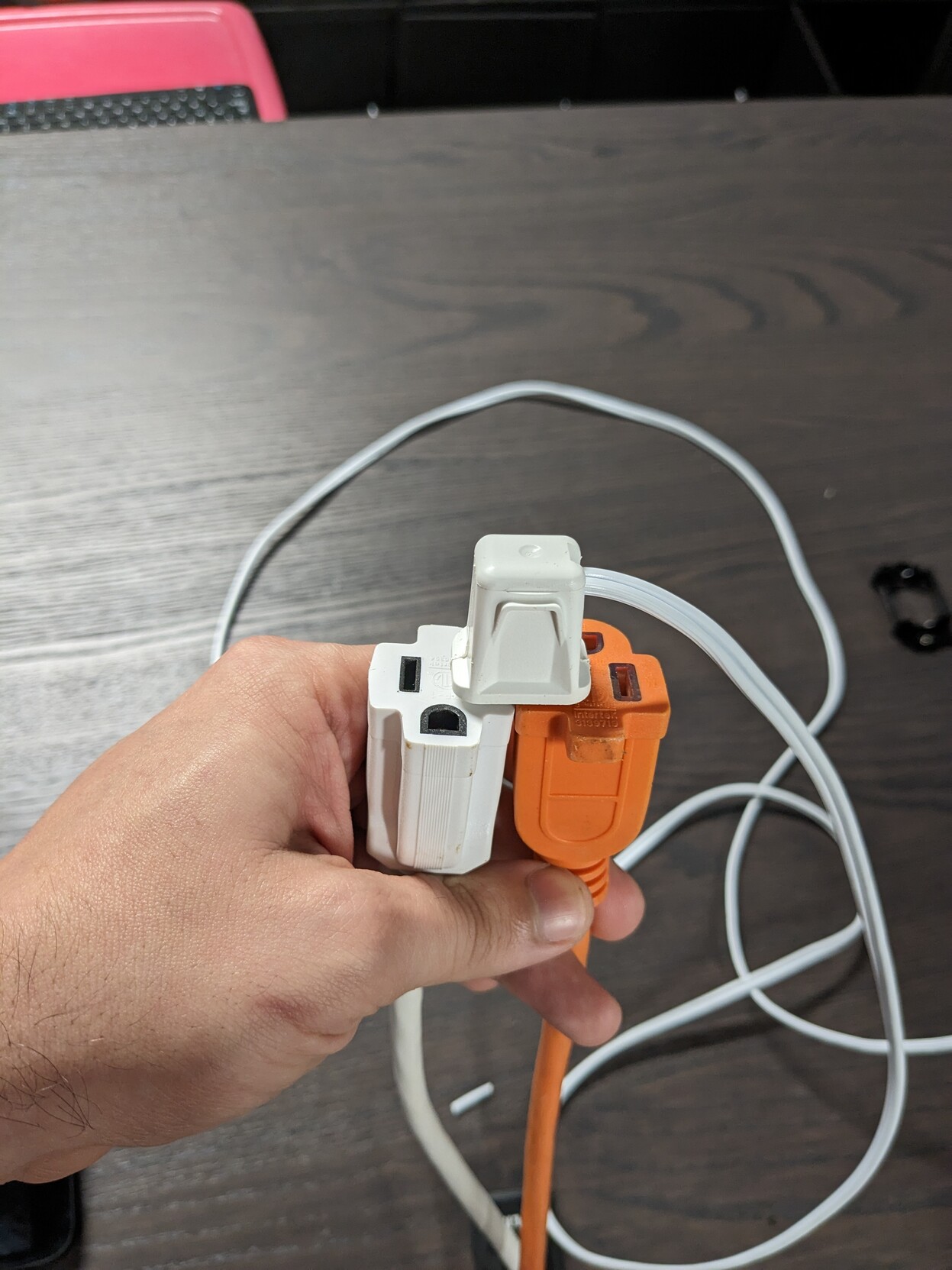And to explain for all my non-North American peeps, these two cords go to plugs that are on adjacent breakers in the panel. That means across the two hot wires you'll get 240V rather than 120V.
So, in a pinch, you can just do this.
Should you? No. But it's possible.
@immibis that's not a jumper it's a plug, the kind you'd do a repair on a lamp with.
So extra dangerous!
@TechConnectify So… is there a "right" way to do this other than to install the standard 240V US style plug like a dryer or stove uses? Is there a legal way to install a 240V UK plug in your home other than a step--up transformer?
@mos_8502 you could install a UK receptacle across two hots and it would /work/ but whether that's legal or not I don't know.
That said, there are 240V plugs for 15 and 20 amp circuits. They're weird and very uncommon but you don't need to go to the extreme of a dryer plug
@TechConnectify #ElectroBOOM approved
@mos_8502 relatedly, someone shared with me that this exists
https://www.leviton.com/en/products/bsrdp-w
Where you can obtain one is unclear but... it exists
@TechConnectify So is that also how a Frencher who had two phases could get 400V?
@ellenor2000 assuming you're incoming power is three-phase and you've got two leads on different breakers, yeah probably
Note: realized that I don't know how obvious it would be that two breakers are fed by different phases so... exact details on that are unclear. But the principle is the same
@TechConnectify this is both hilariously clever and wholly terrifying
@DaveAndAHalf most importantly it worked and I didn't die
@TechConnectify Looks sketchy AF!
@BackFromTheDud no lies detected
@TechConnectify looks way to dangerous 😂
@david heh, I hadn't thought about that. Indeed these circuits are not GFCI protected. But it came in handy just now!
@TechConnectify adjacent is operative here, right? Because that'll mean they're pulling from the opposite phases through separate buses?
Also.. without some kind of protection wouldn't this make *everything* on one of those breakers 240v? Or am I missing something?
@megmac if you haven't seen my video on the US system, it might help
@TechConnectify all the people freaking out amuse me as an electrical engineer, cause I’m like sure that works. It’s all just volts and amps to me.
@Guardian it's safe if you know what you're doing, and honestly only someone who knows what they're doing would even think to do this
But it sure does look sketchy!
@TechConnectify True, do not do this. It won't work because the right hand socket is the hot one.
@samloonie look a little closer
@TechConnectify are you secretly ElectroBOOM??
@TechConnectify Okay, this entire thread led me to (like TechConn said) #RingMains!
OMG! UK? WTF?
@jann Ring mains are cursed
@TechConnectify I’ve wondered if there was a way to wire a receptacle for my UK electric kettle in the US. That wouldn’t have my electrician friends yell at me.
@TechConnectify Can you get 3000W out of it and power a kettle?☕
In the UK you can get 3 phase power installed which is 415V if you've got machinery etc.
What's three phase in America?
@JonoNak Three-phase here depends largely on application.
If you want a building with a basic three-phase service, it's gonna be 120/208. 120 for all convenience receptacles, 208 for anything else. Many commercial buildings have this, plus larger apartment buildings.
But if you've got a really big building or need to power really big stuff, you might have 277/480 and use step-down transformers for other things. And there are higher voltages, too!
@TechConnectify The comments here are… so bad. This is a *demonstration* of the typical US household electrical system working exactly as expected, people. The two out-of-phase sides of your breaker panel bridged is *supposed* to give you 240V — that’s how it’s designed to work for your dryer, oven, AC, EV outlet, etc. He’s not advocating running appliances like this! Relax!
@leoncowle @TechConnectify Having the same plug for 120V and 240V is not good design, if that’s what it is.
@ahltorp @leoncowle (we do not have the same plug for 120 and 240V)
@TechConnectify Then it isn’t working as designed as @leoncowle said.
@ahltorp @leoncowle I don't think that's what was said.
I'm using the principle of our split-phase power (which, as designed, puts 240V across two hot wires) but in a non-standard way.
- replies
- 0
- announces
- 0
- likes
- 0
@ahltorp @TechConnectify I meant the flow of electricity is working as designed -- 240V over two out-of-phase connections on either side of the breaker panel. I wasn't referring to the connector.
@leoncowle @TechConnectify But the connector is sort of the problem in the picture. The 180 degree phase difference isn’t the problem.
@ahltorp @leoncowle OK, so does this look like a normal thing to do? Would someone where you live say "hey, grab two extension leads and jamb a third plug into one half of each?"
Because no, this is in no way normal or a good thing to have set-up. But the same would go for someone jamming a coat hanger into one side of a plug.
I think you're confusing Leon's affirmation of how the system works as an endorsement of this practice. I never read that at all.
@ahltorp @leoncowle What Leon was saying is that, yes, this i indeed how 240V circuits happen in the US. You take two hot leads from adjacent breakers.
This is doing that in a very janky way with extension cords, but /it works/ because this is precisely what's going on with the circuit that powers your dryer, water heater, whatever.
@TechConnectify @leoncowle “This is a *demonstration* of the typical US household electrical system working exactly as expected, people.”
Sounds quite clear to me. Also sounds like the US plugs are among the worst ever invented.
@ahltorp @leoncowle Our plugs are indeed bad, yes.
But I dunno. You've missed that "a demonstration into how something works" isn't necessarily followed by "in practice"
I think Leon's baffled by people not understanding that this is exactly what's happening in your panel, and you've falsely assumed he meant this is exactly what happens behind your dryer.
@TechConnectify @leoncowle But it doesn’t work, since you put 240V into a 120V connector.
@ahltorp @leoncowle huh?
I did this to wire something up on a test bench. It needed 240V (or rather, I needed to supply it with 240V for a test).
So I used two extension cords, plugged into circuits on different breakers, then shoved a plug across their two hots. Now I have 240V on the other end of that plug, which I used for my test.
Here, this explains what's happening.
https://en.wikipedia.org/wiki/Split-phase_electric_power
@TechConnectify @leoncowle Every single comment I read was about how it’s unholy to connect things this way, not that it’s strange that you get 240V.
@ahltorp Then you've just read way too much into this, and also missed the last sentence apparently.
@TechConnectify @leoncowle I know exactly what’s happening, that’s why I (and most commentors) are appalled.
@ahltorp @leoncowle Alright, I'm out. You said it doesn't work, then said you know what's happening.
I don't even know what you're trying to argue at this point.
@TechConnectify can't find the pic, but i found a power cable with two male ends in the remnants of a tenant
(Since he had sheep and other animals, i really don't want to know why... )
@TechConnectify @leoncowle You’re feeding the connector higher voltage than it and the cable is designed for. What’s difficult to understand about that?
@ahltorp @leoncowle ...the fact that you think either of us are unaware of how sketchy this is.
Again. Read the entire original comment. I think you made a leap somewhere.
@TechConnectify @leoncowle No, it’s quite obvious that you thought it was sketchy in one way, but you missed another way it was sketchy. Don’t do this, but certainly don’t do this if you think what you’re doing, because you don’t.
@ahltorp Cool.
Edit: Actually, I think I just got this. Do you think "this works" means "this is safe, within code, up-to-par" etc? Because that's wild to me. Genuinely.
I simply mean "it functions." In the same way that you could plumb a home with garden hoses - that would work. It's a terrible idea, but that would /work/
If this is another weird language barrier thing we've discovered, then neat! A strange disagreement in terms is all this was.
@TechConnectify No, it’s like trying to connect your garden hose to a faucet via a plastic bag. Your post is insidious, since on the surface there’s one problem with the connection, but there are actually two problems, if not three.
@ahltorp Alright, all I can do now is laugh.
You have a good evening.
@TechConnectify @mos_8502 You could even use one of these fancy UK receptacles that fits in a US style box. https://www.leviton.com/en/products/bsrdp-w



